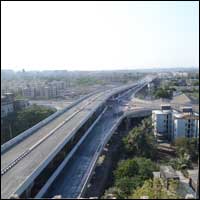The Indian construction sector is plagued by want of multiple clearances which is escalating the total project cost. The requirement of multiple clearances and consequently the delay in project execution is raising construction costs by a steep 40 to 50 per cent, say industry insiders. A proper mechanism or single-window system could help avoid unnecessary time and cost overrun in projects, they point out.

Senior ED (Project Management Group), CBRE South Asia
The host of clearances from local, state and central agencies—which are as far apart as tree authority and storm water and sewerage, hydraulics and environment and forests, traffic and fire clearance, and defence and coastal regulation—are adding to the confusion, so much so that promoters have even been compelled to pull out their projects and invest elsewhere.

Head of Project Control,
L&T ECC
“It depends from project to project. What clearances are stuck and how long it takes. Ultimately, the factors that contribute to the cost of a project include cost of materials and labour, and time. Therefore, if the time spent on a project gets prolonged due to lack of clearances then it increases project cost. If a builder has taken loans from banks or lenders then the interest component rises, as does the cost of materials, resulting in overall increase in project cost,” Gurjot Bhatia, Senior Executive Director (Project Management Group), CBRE South Asia Pvt. Ltd, said on the sidelines of the CII Conference on Infrastructure and Project Management held in Mumbai recently.
According to Bhatia, it also depends at what stage of the project the clearances are pending but the escalation could be substantial. In residential projects, for instance, even if the prices rise by 5 to 10 per cent, it has a huge impact on the end users. He referred to cyclical escalations, such as in the cost of materials that can also impact the project.

Director,
Runwal Group
“The cost escalation in a project also depends on where the project is located and who the stakeholders are. If there is any hindrance then the collective opinion of the various stakeholders is taken and acted upon,” said Rajesh Kanade, Head of Project Control, L&T ECC, which being a contractor is not directly involved in approvals and clearances.
Addressing the conference, Subodh Runwal, Director, Runwal Group, said that the existing, approval systems were posing a major roadblock in managing projects. He called for a single or just a couple of windows clearing system, rather than the multi-layer clearing system that exists today. With respect to project management, Runwal emphasised the importance of keeping the team motivated to take any project towards completion. He also pointed out that today the middle class found housing unaffordable in Mumbai as the infrastructure costs were very high. Cash flow management was one of the key aspects here and it should be planned out well.

MD,
TG Group
Noting that project management played an important role in seeing various projects towards completion, Vinod Gowani, Managing Director, TG Group, said, “There are three things that are urgently required in this sector: tax holidays, speedy customs clearances, and lastly, continuous inflow of highly skilled engineers.” He hoped that the government would take steps to ensure these things happened soon.
Ninad Karpe, Managing Director and Chief Executive Officer, Aptech, and Past Chairman, CII Maharashtra State Council, believed that infrastructure projects had been facing tough times, but at the same time they had successfully managed to stay afloat by innovating the way they conducted business.
India has planned to implement infrastructure projects worth around $1 trillion during the ongoing 12th Five-Year Plan period (2012-2017) and is hoping for increased private sector participation to the tune of nearly 50 per cent ($500 billion). But delays due to clearances and the resultant hike in costs could make projects across sectors a financial risk. Until this critical issue is sorted out, the private sector will remain sceptical about investing in India’s infrastructure development projects. Without private sector participation, the infrastructure investment target of $1 trillion will remain a pipe dream.
Photos: Anthony Azavedo











